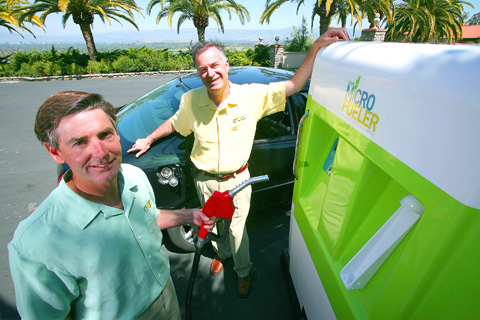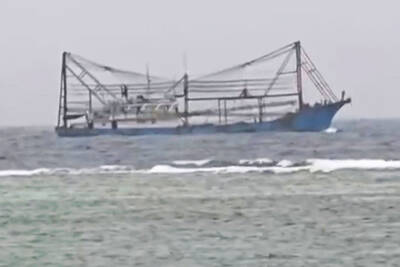What if you could make fuel for your car in your backyard for less than you pay at the pump? Would you?
The first question has driven Floyd Butterfield for more than two decades. Butterfield, 52, is something of a legend for people who make their own ethanol. In 1982, he won a California Department of Food and Agriculture contest for best design of an ethanol still, albeit one that he could not market profitably at the time.
Now he thinks that he can, thanks to his partnership with the Silicon Valley entrepreneur Thomas Quinn. The two have started the E-Fuel Corp, which will soon announce its home ethanol system, the E-Fuel 100 MicroFueler. It will be about as large as a stackable washer-dryer, sell for US$9,995 and ship before year-end.

PHOTO: NY TIMES NEWS SERVICE
The net cost to consumers could drop by half after government incentives for alternate fuels, such as tax credits, are applied.
The MicroFueler will use sugar as its main fuel source, or feedstock, along with a specially packaged time-release yeast the company has developed. Depending on the cost of sugar, plus water and electricity, the company says it could cost as little as a US$1 a gallon (US$0.26 per liter) to make ethanol. In fact, Quinn sometimes collects leftover alcohol from bars and restaurants in Los Gatos, California, where he lives, and turns it into ethanol; the only cost is for the electricity used in processing.
In general, he says, burning a gallon of ethanol made by his system will produce one-eighth the carbon of the same amount of gasoline.
“It’s going to cause havoc in the market and cause great financial stress in the oil industry,” Quinn boasts.
He may well turn out to be right. But brewing ethanol in the backyard isn’t as easy as barbecuing hamburgers. Distilling large quantities of ethanol has typically required a lot of equipment, says Daniel Kammen, director of the Renewable and Appropriate Energy Laboratory at the University of California, Berkeley. In addition, he says that quality control and efficiency of home brew usually pale compared with those of commercial refineries.
Quinn, 53, has been involved with successful innovations before. For instance, he patented the motion sensor technology used in Nintendo’s wildly popular Wii gaming system.
More to the point, he was the product marketing manager for Alan Shugart’s pioneering hard disk drive when the personal computer was shifting from a hobbyists’ niche to a major industry.
“I remember people laughing at us and saying what a stupid idea it was to do that disk drive,” Quinn says.
Butterfield thinks that the MicroFueler is as much a game changer as the personal computer. He says that working with Quinn’s microelectronics experts — E-Fuel now employs 15 people — has led to breakthroughs that have cut the energy requirements of making ethanol in half. One such advance is a membrane distiller, which, Quinn says, uses extremely fine filters to separate water from alcohol at lower heat and in fewer steps than in conventional ethanol refining. Using sugar as a feedstock means that there is virtually no smell and its water byproduct will be drinkable.
E-Fuel has bold plans: It intends to operate internationally from the start, with production of the MicroFueler in China and the UK as well as the US. And Butterfield is already at work on a version for commercial use, as well as systems that will use feedstocks other than sugar.
Ethanol has long had home brewers and permits are available through the Alcohol and Tobacco Tax and Trade Bureau. You must be a property owner and agree to make your ethanol outdoors.
But there are plenty of reasons to question whether personal fueling systems will become the fuel industry’s version of the personal computer.
For starters, sugar-based ethanol doesn’t look much cheaper than gas. Raw sugar sells in the US for about US$0.20 a pound (0.45kg) and it takes 10 pounds to 14 pounds of sugar to make a gallon (3.79 liters) of ethanol, says Michael Salassi, a professor in the department of agricultural economics at Louisiana State University. But Quinn says that as of January, under the North American Free Trade Agreement, he can buy inedible sugar from various markets for as little as US$0.025 a pound, which puts the math in his favor. While this type of sugar has not been sold to consumers, E-Fuel says it is developing a distribution network for it.
In addition, it’s illegal in the US to operate a car on 100 percent ethanol, with exceptions for off-road vehicles like Indy cars and farm equipment.
Quinn has a federal permit to make his own fuel and believes that if MicroFuelers start popping up like swimming pools, regulators will adapt by certifying pure ethanol for cars.
Despite all the hurdles, Quinn and Butterfield may be on to something. There are plenty of consumers who want to reduce their carbon footprint and are willing to make an upfront investment to do it — consider the success of the Prius.

A Chinese aircraft carrier group entered Japan’s economic waters over the weekend, before exiting to conduct drills involving fighter jets, the Japanese Ministry of Defense said yesterday. The Liaoning aircraft carrier, two missile destroyers and one fast combat supply ship sailed about 300km southwest of Japan’s easternmost island of Minamitori on Saturday, a ministry statement said. It was the first time a Chinese aircraft carrier had entered that part of Japan’s exclusive economic zone (EEZ), a ministry spokesman said. “We think the Chinese military is trying to improve its operational capability and ability to conduct operations in distant areas,” the spokesman said. China’s growing

Nine retired generals from Taiwan, Japan and the US have been invited to participate in a tabletop exercise hosted by the Taipei School of Economics and Political Science Foundation tomorrow and Wednesday that simulates a potential Chinese invasion of Taiwan in 2030, the foundation said yesterday. The five retired Taiwanese generals would include retired admiral Lee Hsi-min (李喜明), joined by retired US Navy admiral Michael Mullen and former chief of staff of the Japan Self-Defense Forces general Shigeru Iwasaki, it said. The simulation aims to offer strategic insights into regional security and peace in the Taiwan Strait, it added. Foundation chair Huang Huang-hsiung

PUBLIC WARNING: The two students had been tricked into going to Hong Kong for a ‘high-paying’ job, which sent them to a scam center in Cambodia Police warned the public not to trust job advertisements touting high pay abroad following the return of two college students over the weekend who had been trafficked and forced to work at a cyberscam center in Cambodia. The two victims, surnamed Lee (李), 18, and Lin (林), 19, were interviewed by police after landing in Taiwan on Saturday. Taichung’s Chingshui Police Precinct said in a statement yesterday that the two students are good friends, and Lin had suspended her studies after seeing the ad promising good pay to work in Hong Kong. Lee’s grandfather on Thursday reported to police that Lee had sent

A Chinese ship ran aground in stormy weather in shallow waters off a Philippines-controlled island in the disputed South China Sea, prompting Filipino forces to go on alert, Philippine military officials said yesterday. When Philippine forces assessed that the Chinese fishing vessel appeared to have run aground in the shallows east of Thitu Island (Jhongye Island, 中業島) on Saturday due to bad weather, Philippine military and coast guard personnel deployed to provide help, but later saw that the ship had been extricated, Philippine navy regional spokesperson Ellaine Rose Collado said. No other details were immediately available, including if there were injuries among